

Qualitative Thermography is the art and science of detecting, displaying, and recording the thermal patterns across the
surface of an object.
All objects on the planet (above 0°K or ‘absolute zero’) emit infrared radiation. Infrared radiation is part of the
electromagnetic spectrum that includes visible light but its wavelength is longer, making it impossible to see without
special equipment. Since infrared radiation is emitted by all objects based on their temperature, the higher the
temperature, the higher the amount of radiation emitted.
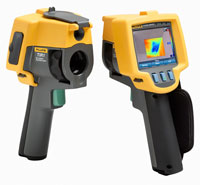
Thermographers use thermal imagers, like that ones seen at left to
detect that radiation. The thermal imagers convert the emitted
invisible radiation into a visible light image. A properly trained and
certified thermographer can interpret the variations in temperature
and provide valuable information that cannot be attained by traditional
methods of inspection.
detect that radiation. The thermal imagers convert the emitted
invisible radiation into a visible light image. A properly trained and
certified thermographer can interpret the variations in temperature
and provide valuable information that cannot be attained by traditional
methods of inspection.
| Notice the difference between the visible light image and the infrared image of our dog Daisy. The red, yellow, and green are warmer areas, like her ears, mouth and belly; the aqua, blue and purple are cooler. |
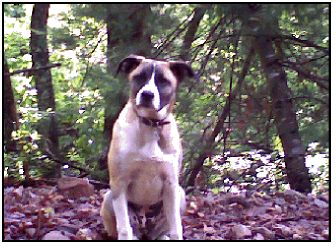
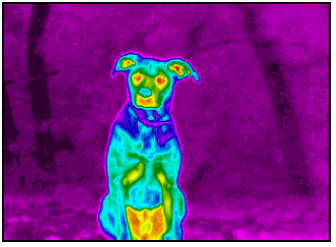
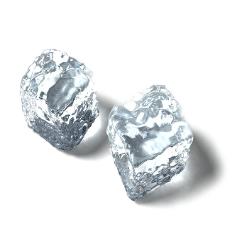
The laws of thermodynamics are foundational in
understanding the basis for thermography:
- First Law of Thermodynamics: Energy cannot
be created or destroyed. Energy can be
transformed and transferred but the total
amount always stays the same.
- Second Law of Thermodynamics: Systems in
contact with each other tend to balance but will
flow naturally in only one direction – hot to cold.
In other words, thermal energy will always flow
from the warmer object to the cooler object until
the objects are the same temperature.
To illustrate this, place an ice cube in your hand. Does your hand freeze or does the ice
melt? The ice melts because when the ice touched your skin, the thermal energy in your
warm hand transferred into the cool surface of the ice cube, causing it to melt. If you had
removed the ice cube from your hand before it melted, you would have been able to feel a cold
spot on your hand where it sat – not because the ice made your hand cold, but because the
cold ice ‘drew’ the heat out of your hand like a magnet.
Is it safe?
Yes. Thermography is a passive
technology and is as safe as using an
ear thermometer to check a baby’s body
temperature. You see, the baby is
emitting infrared radiation and the point
radiometer (a.k.a. 'ear thermometer')
converts that into a number displayed
on the LCD screen. The only difference
between a thermal imager and a
radiometer is that the thermal imager
measures thousands of points at a
time and turns them into a picture while
a point radiometer simply measures a
single point and displays its value.
Yes. Thermography is a passive
technology and is as safe as using an
ear thermometer to check a baby’s body
temperature. You see, the baby is
emitting infrared radiation and the point
radiometer (a.k.a. 'ear thermometer')
converts that into a number displayed
on the LCD screen. The only difference
between a thermal imager and a
radiometer is that the thermal imager
measures thousands of points at a
time and turns them into a picture while
a point radiometer simply measures a
single point and displays its value.
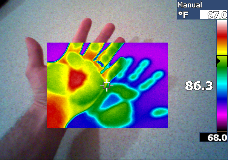
This is even easier to illustrate with the use of thermography. If I place my warm hand on the cool surface of a table, the heat
energy will flow out of my hand and into the table, warming the table where my hand was and leaving my hand less warm (until my
body replaces the heat, which it does quickly). So, again, energy isn’t created or destroyed, it just moves from one place to
another, flowing from warmer to cooler.


Let’s say it’s winter. The inside of your house is warm ($$$) but the outside is very cold (brrrr!). There are two systems, warm
and cold, in contact with each other: which way does the energy want to flow? Right, the warmth wants to flow to the cold
outdoors. You however, want to prevent this transfer. So you have R-13 insulation in your walls. The R-value of your
insulation means that it will ‘R’esist the heat transfer – the higher the number the more it will resist the transfer. R-13 is
relatively standard in walls, the problem is your walls are not made entirely of insulation. Most likely, your wall is framed out of
2x4’s or 2x6’s. A 2x4 only has an r-value of about 4.5. With studs on 16”centers, almost 10% of your wall is made of wood.
That means on a 40’ wall (8’ high) there are 32 square feet with only R-4.5! This number is almost always higher due to
traditional framing practices that utilize many more studs than every sixteen inches.
Knowing what we know about heat transfer, we know that the cold outdoors will draw the heat from your home out through the
wood in your walls faster than through your insulation. We can also presume then that the wood in your walls will be a cooler
temperature than the cavities where the insulation is installed.
Enter thermography. The picture below shows an interior wall on a mildly cold day – notice in the infrared image that there is
a temperature difference on the surface of the sheetrock where the studs are – this is literally a clear picture of where the heat
is being transferred out of the building.
[Please note that I said a ‘temperature difference on the surface of the
sheetrock’… Some thermographers inadvertantly mislead potential
customers by advertising that they can ‘see inside your walls’. That claim is
misleading in the same way as if I claimed to be able to see your car’s
engine by placing my hand on the warm hood of your car. Now, two facts I
know to be true, 1) your hood is warm and 2) engines create heat when they
run; together, those two facts may be enough for me to make an educated
guess that there’s an engine underneath, but it doesn’t make me able to
‘see’ your engine. Check your thermographer’s training and certification
before you hire him. We use the Infraspection Institute for our training.
Founded in 1980 they are the oldest independent infrared training and
certification firm in the world. Click here to see our certification.]
While this is neat to see, you're probably not planning to tear down the wall and try to use fewer studs. However, the same
thermodynamic activity is visible where insulation is missing, damaged, or improperly installed – now that’s something you
can fix! Knowing that you’re starting out with a maximum of only 90% of your walls insulated – it’s even more important to make
for certain that 90% is in place and doing its job. And that’s something only a trained and certified thermographer can tell you.
Click here to learn more about Compass Energy Loss Surveys.

